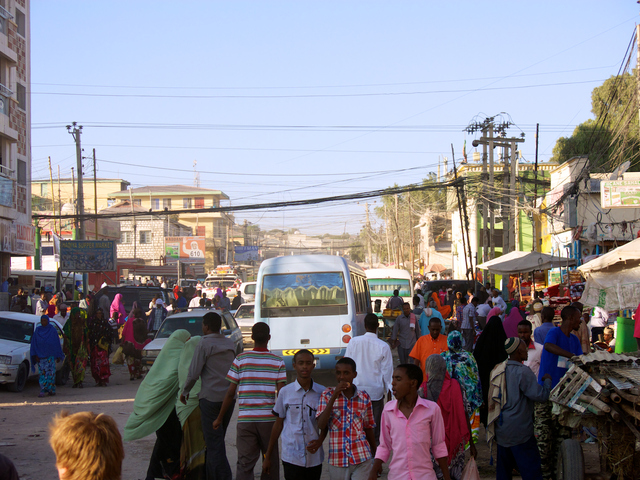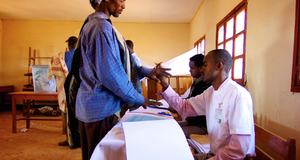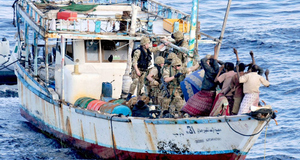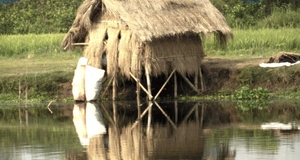Featured Article:State Building in Somalia in the Image of Somaliland: A Bottom-Up ApproachThe Clan System in Somali PoliticsThe ethnic Somali population is divided into six major clan groupings. In the north the Isaaq and Darod control most of the area comprising Somaliland and Puntland respectively while in the south the Hawiya, Rahanwein and Digil occupy the rest of Somali territory (lib.utexas.edu). Djibouti, to the northwest of Somaliland, is home to a smaller Dir clan. Darod and Hawiya clans also occupy areas in Ethiopia and Kenya (Greater Somalia). Steve Kibble writes, “the history of Somalia is impossible to understand without some knowledge of the interweaving of an un-centralized egalitarian political system…with the effects of British, French and Italian formal colonization… and the attempt to create a post-colonial modernist nation state” (2001, p.10). By reviewing the role of clans and clan elders in Somali society and their ability to reconcile violence between clans and sub-clans after the civil war, we see that the single strongest institution remaining in Somali society may be that of clan leadership. Clan affiliation is one of the most important units of identity within Somali society and is based on patrilineal descent. Somalis, like many Muslim societies, typically trace their ancestry back to the Prophet Mohammad and “an understanding of the political relationships between groups requires a knowledge of their genealogical relationships” (Pham, 2012, p5). Within clans are sub-clans and sub-sub clans known as dia-paying groups and organized so “that families within the group have a collective responsibility for settling acts committed by, or against their members.” Dia groups are considered the most stable unit within Somali culture (Ahmed & Green, 1999, p.114) and interaction of dia groups forms the basis of relations in Somali social order. Richard Posner (1980) sees the connections developed within collective guilt units such as dia as cornerstone of Somali society. Alliances between dia groups “join or split in a fluid process of ‘constant decomposition and re-composition’” typically working through a “diffuse and decentralized decision making process” (Kaplan, 2008, p.145).  Hargeisa, Somaliland's center of commerce and government, is a safe and bustling metropolis when compared to ravaged Mogadishu. Photo: Dustin Turin.
Hargeisa, Somaliland's center of commerce and government, is a safe and bustling metropolis when compared to ravaged Mogadishu. Photo: Dustin Turin.
The civil war saw dia groups and clans battle amongst and against each other in constantly shifting alliances. Continued bloodletting created massive debts between dia groups that could not possibly be paid and perpetuated violence throughout Somalia. The concept of long-lasting conflict in traditional Somali society was rare because dia ideals of collective security and guilt precluded such action. “The principle of collective responsibility enables the society to set a level of compensation higher than the average individual can pay since his kinsmen are liable for the judgment debt” (Posner, 1980, p.46). This traditional system came under duress during the civil war because dia groups were unable to pay the debts their members incurred, while continued fighting exponentially increased the debts owed. In Somaliland, clan elders were eventually able to reconcile blood money payments by the dia groups in order to counter the detrimental effects of civil war. Clan elders in Somalia carry considerable political and social weight because they are chosen by “virtue of personal attributes,” not simply age (Ahmed & Green, 1999, p.123). Debiel et al. see the “composition and relative strength of local elites” as “decisive factor[s]” in the ability for a fledgling state to develop (2009, p.38). As stated above, the debts accrued between these groups were too large, and quickly became too complex to adjudicate and resolve under traditional Somali contract law (xeer), which is based on the dia groups having to share the burden of compensation between members. Xeer is an “inter-family social contract” (Jhazbhay, 2009, p.57) and based on ad hoc committees of judges who resolve disputes and are well respected within the clan communities. Xeer is centered on property and the understanding that crime can only be defined in terms of property. Therefore “there can only be crimes against individuals, and justice is compensatory, not punitive” (Lutter, 2011). The reason Somali society reached this breakdown can be traced back to the colonial institutions and post-colonial state that arose after independence. The colonial state did not emphasize the traditional elements of Somali society such as dia groups and xeer. European colonization “did not originate to assist African countries to develop… It originated to benefit European countries” (Gordon & Gordon, 2012, p.119). The institutions that Europeans left in place were the same institutions that would develop into a system based on autocratic, patrimonial rule and predatory systems. These institutions ignored clan structures except for the purposes of extending and strengthening the patron-client systems that became the status quo after independence. During the post-colonial period, there was no emphasis on clan-based governance. Colonial and State GovernmentsNo stable western-style government existed in Somalia before the Italian administration in southern Somalia, while present day Somaliland was an important link in a Haud, Hargeisa, Berbera, Arabia trade axis. The imposition of artificial colonial borders changed the traditional authority structures and the equilibrium of clan management (Kibble, 2001, p.11) as well as the pastoral society of Somalia. “With the creation of these artificial (colonial) boundaries, cohesive social groups were separated and logical and well-established trading areas were divided” (Gordon & Gordon, 2012, p.64). There was never an effective attempt by British colonial authorities to change the structure of Somali society, as opposed to the Italians who attempted to remake Somali culture and civil society in a more European image. This is attributed to what Fredrick Lugard referred to as “indirect rule” whereby “British rule could be maintained at minimal cost by delegating all local power to existing elites, retaining only the essentials of central authority (in particular the purse strings) in British hands” (Ferguson, 2002, p.175). Somali governance under the British did not entail institution building in any meaningful way. Clan elders retained their power and position in society while furnishing the colonial government the extractive capacity to maintain administrative cohesiveness (Kibble, 2001, p.8). In the case of British Somaliland, continued exertion of social and political power by clan elders lead to the prospect of a more stable government after the ouster of Barre in the early 1990s. By contrast, Italian administration of southern areas was eclectic at best. Malvezzi contends that “Italy had no (colonial) system” and had “worked out colonial policy on practical, rather than on theoretical lines” (Malvezzi, 1927, p.234). Like the British; administration of Italian Somaliland was designed so “infrastructure development was perpendicular to the coast for resource extraction” (Malvezzi, 1927, p.241). Unlike the British; Italian governance of Somalia was supposed to be more direct, removing the traditional political power of the clan elders in favor of a more centralized system. Where the British “preferred to leave such governance as was needed on a day-to-day basis in the hands of Somali elders” Italy embarked on a policy of attempted cultural change by displacing traditional structures, such as “supplanting xeer and other traditional Somali usages with institutions imported from Italy” (Pham, 2012, p.9). The resulting manipulation of Somali society in Italian controlled territory led to a disjointed and unorganized government. “In no case… did European colonizers invest in cogent, rational programs of development designed to make African states self-sufficient” (Gordon & Gordon, 2012, p.119). The smaller clans of Italian Somaliland continued to have their traditional governance replaced by western imposed institutions in an attempt to ready the territory for independence. As with most African states, “The transition from colonial despotism to liberal democracy was expedited in a few years without any fundamental transformation in the economic, cultural, or bureaucratic domains” (Fatton Jr., 1990, p.457). This subsequently left Somali society with no means to coalesce around a centralized authority upon independence. “As a result, notions that authoritarianism was an appropriate mode of rule were part of the colonial political legacy” (Gordon & Gordon, 2012, p.67) and drove Somalia and many other African states to develop a highly patrimonial centralized government after independence. Post-colonial development in Africa focused on “the state, rather than the individual or the market” (Kibble, 2001, p.6). The creation of The Republic of Somalia in 1961 was the result of unification between British and Italian controlled territories; the creation of a strong central government in the south would prove detrimental to traditional clan roles within Somali society. The Republic of Somalia quickly became a powerful central authority, government institutions were concentrated in the southern capital city of Mogadishu and the traditional clan-based pastoral society was supplanted by a southern dominated socialist state. “There were very high initial expectations about the role the state would play as the prime mover in all development efforts” (Doornbos, 1990, p.182) and there was a feeling that the state alone needed to push modernization forward (Barkey and Parikh, 1991). Clan participation in government quickly became a key to economic success through access to the large amount of foreign aid which was pumped into the Somali state. In much the same way social and ethnic cleavages formed the basis of political party formation in other post-colonial states (Gordon & Gordon, 2012, p.72); Somali politics was based upon the clan and which one was favored by Siad Barre. The patrimonial nature of the Barre regime enhanced divisions between the clans in order to increase the power of the ruling elites in Somalia. While Barre was fairly successful in keeping the majority of the foreign aid delivered to Somalia during his dictatorship for enrichment of his own coffers, the distribution of the remaining money from the centralized government became a contest of patronage and loyalty. By the mid-1980s 58% of Somali Gross National Product (GNP) came from foreign aid (UNDP 1998 as cited in Leeson, 2007, p.14). Ken Menkhaus believes this created a view of the state as, “the primary source not only of power but of wealth-as the catchment point for foreign aid…and as the coercive instrument with which empowered clans and coalitions have expropriated the assets of rivals” (2006, p.80). Barre’s hold on power and the predatory nature of the Somali state under his control has made the idea of a western-style top down government implausible for the Somali people. Douglas North (1990) sees the function of institutions in a society as to “reduce uncertainty by establishing a stable (if not necessarily efficient) structure to human interaction” (p.6). Institutions of the Somali Republic could be seen in the light of other “developmental dictatorships” of Africa. Richard Sklar saw these systems as leading to “corruption and injustices; instead of promoting economic development they fostered material stagnation and decline; instead of establishing viable political order they engendered divisive tendencies, military coups and civil wars” (as cited in Fatton Jr., 1990, p455). The result of Barre’s overdeveloped predatory state was the destruction of traditional societal factors which would have prevented the civil war which ensued after his ouster. North also highlights two points related to the direction of state resources “(1) The institutional framework will shape the direction of the acquisition of knowledge and skills and (2) that direction will be the decisive factor for the long run development of that society” (1990, p.79). Traditional clan structures were too worried about survival in a patrimonial system to create the investments in human capital necessary to develop Somalia. Meanwhile the state was over dependent on foreign aid, used to perpetuate the patron-client systems which had started under colonial rule to develop the physical infrastructure necessary to develop Somalia economically. The result was a total collapse of the state under its own inabilities.Continued on Next Page » Suggested Reading from Inquiries Journal
Inquiries Journal provides undergraduate and graduate students around the world a platform for the wide dissemination of academic work over a range of core disciplines. Representing the work of students from hundreds of institutions around the globe, Inquiries Journal's large database of academic articles is completely free. Learn more | Blog | Submit Latest in Political Science |


















